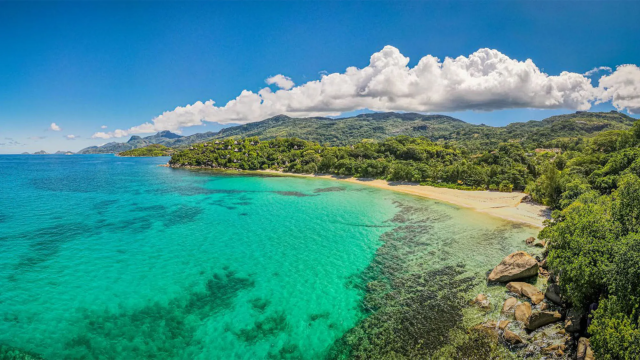Seychelles strives for ‘a better kind of tourism’
2023-12-17Sustainability has become indispensable for Seychelles. That was the consensus at a recent Experience Seychelles Mega Fam event hosted by Tourism Seychelles, with over 65 travel industry attendees worldwide.
The granite islands of Seychelles harbor natural riches, including roughly 75 endemic plant species. Visitors can see curiosities like the tiny Seychelles frog (about the size of a pinky finger) and the giant tenebrionid beetle, the world’s biggest flying insect. About 335,000 visitors come to Seychelles yearly, attracted specifically by these extraordinary ecological treasures, which the Seychelles government is working hard to protect and preserve.
• Related: Tribute Portfolio resort opens in the Seychelles
In August, the government introduced an environmental sustainability levy for travelers that will help safeguard the destination’s natural beauty for future generations. The levy is part of a broader strategy by the Seychelles government to promote responsible travel. With this approach, the Seychelles is not only preserving its rich environmental heritage but also offering travelers a chance to be part of a larger, global conservation effort.
“Fifty percent of our landmass and 30% of our sea territory is protected, because we are not just safeguarding the islands for future generations but also making sure we are taking care of our bread and butter,” said principal secretary of tourism Sherin Francis. “Our strategy going forward is to build a better kind of tourism for Seychelles. Higher value, lower impact.”
It’s not only the government that understands the importance of investing in sustainability” the country’s hotels and other stakeholders are actively contributing, too.
Committed to community, conservation
At the Hilton Seychelles Labriz Resort and Spa, located on Silhouette Island, the aim is not just to provide spectacular beaches and unforgettable luxury experiences but also to empower local island communities. The on-site hospitality training college enables Seychellois youth to develop careers in tourism, with placements at Hilton resorts worldwide. By investing in local talent, Hilton fosters economic mobility and pride in the tourism industry, which it says is critical to preserving the islands.
When Hilton built its resort on Silhouette, it decided to leave the original homesteads on the land untouched. The hotel maintains those homesteads for the original owners, who tend to work on the main island of Mahe, so that they can return for weekend stays or vacations.
Rebuilding reefs
Club Med Seychelles has an enviable location on Saint Anne Island, which is the first island in Seychelles that settlers put down roots. It became a marine national park in 1973 and was the first of its kind in the Indian Ocean to offer protection for wildlife.
Club Med has taken significant steps toward environmental conservation. Recognizing the critical state of the coral reefs surrounding the islands, Club Med has launched a program to rehabilitate the fragile ecosystems, partnering with marine biologists and local experts to restore damaged reefs and protect the marine life that relies on them.
The rehabilitation of coral reefs not only contributes to Seychelles’ ecosystem health but also ensures the long-term sustainability of snorkeling and diving experiences, which are integral to the tourism industry.
Another ecofriendly decision: You won’t see personal watercraft roaring through the waters at Club Med. Only nonmotorized sports are on the activity menu.
Choosing nature reserve over resorts
At the Cap Lazare Nature Reserve, sustainability shapes everything. The 150-acre, family-owned refuge is found in the wilderness of Baie Lazare, Mahe. Despite substantial resort interest (there have been many offers to buy the land), the Albert family instead invested in more land. They acquired neighboring plots to establish a nature reserve focused on preserving biodiversity and celebrating Seychellois culture.
Cap Lazare now provides a sanctuary for giant Seychelles tortoises to roam freely. It also hosts events, from private launches to yoga retreats to weddings, where the Unesco-listed Moutya dance and Creole restaurant enable visitors to experience conservation and culture in one location.
A sustainable success story
Seychelles has struck an innovative balance of conservation and business through sustainable harvesting of the iconic coco de mer nut. This rare palm tree nut, weighing up to 80 pounds, is native only to two protected islands in Seychelles. Local lore traces the curious shape of the male and female nut to the forbidden love between ancient gods immortalized in the palms. Following strict governmental oversight, a small harvest ensures future yields are unaffected. Selected female nuts are replanted or left undisturbed, while only certified nuts can be sold, supporting regeneration processes critical to this endemic species’ survival.
Nothing is wasted. The kernels are processed for cooking and health products, while artisans craft perfumes at an on-site factory that subtly capture the nut’s essence. This creative enterprise spotlights Seychelles’ pioneering green models linking tourism to heritage and ecology. It also enables locals’ incomes while respecting biodiversity.
Widespread efforts to support these sorts of conservation efforts, empower local communities, and promote cultural heritage will no doubt help preserve the unparalleled beauty of Seychelles.
Courtesy of Travel Weekly


